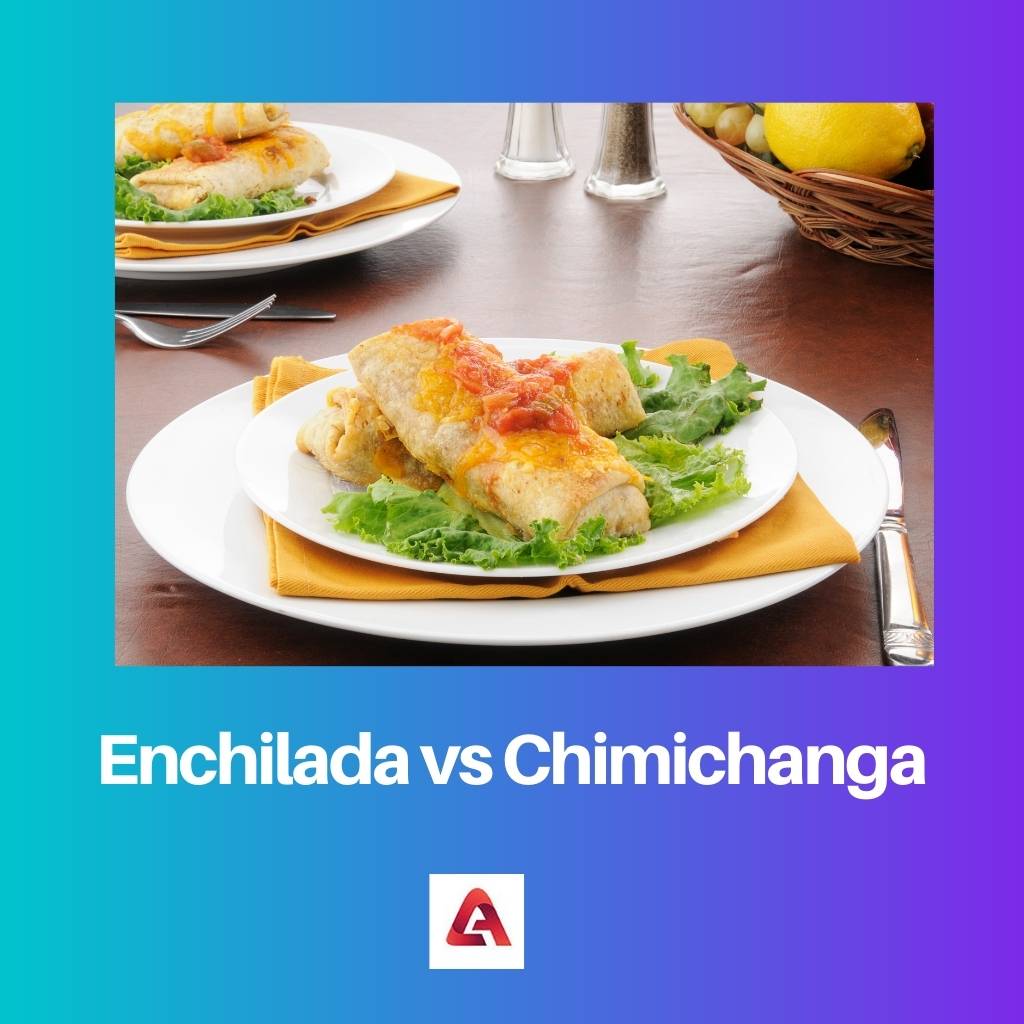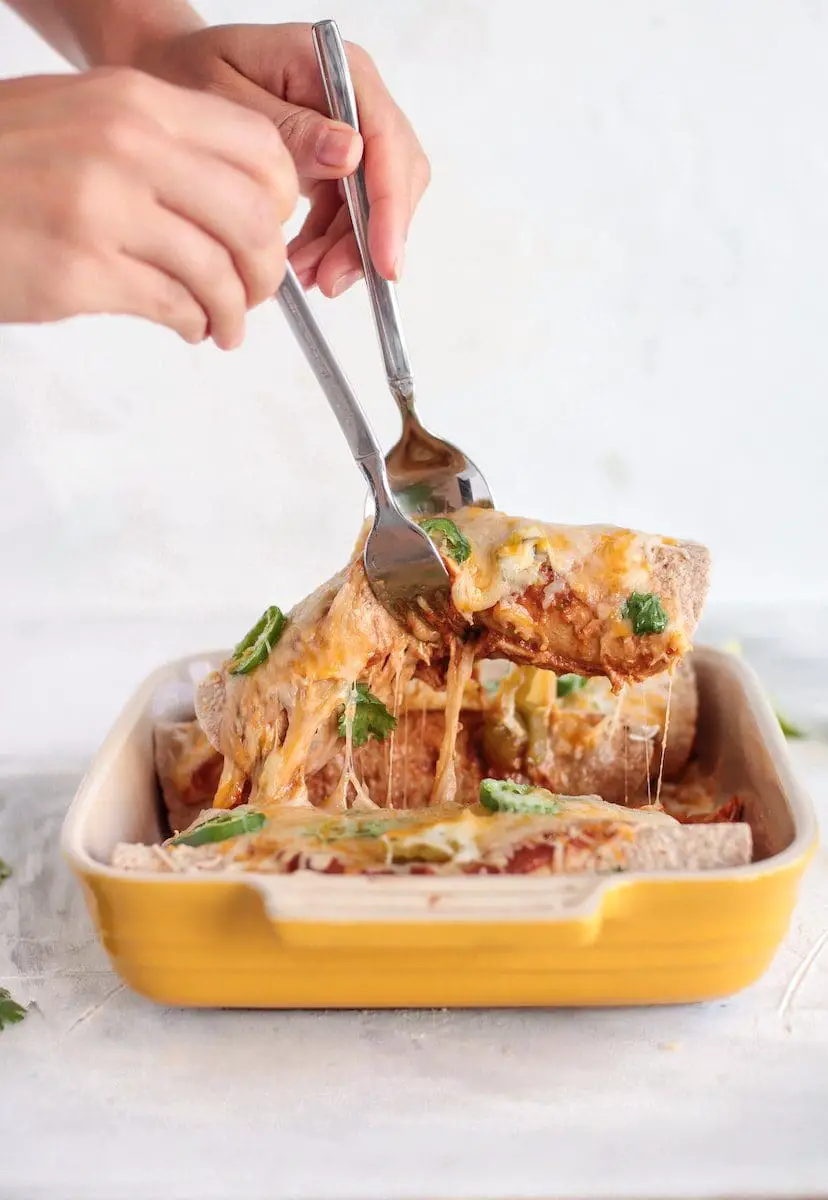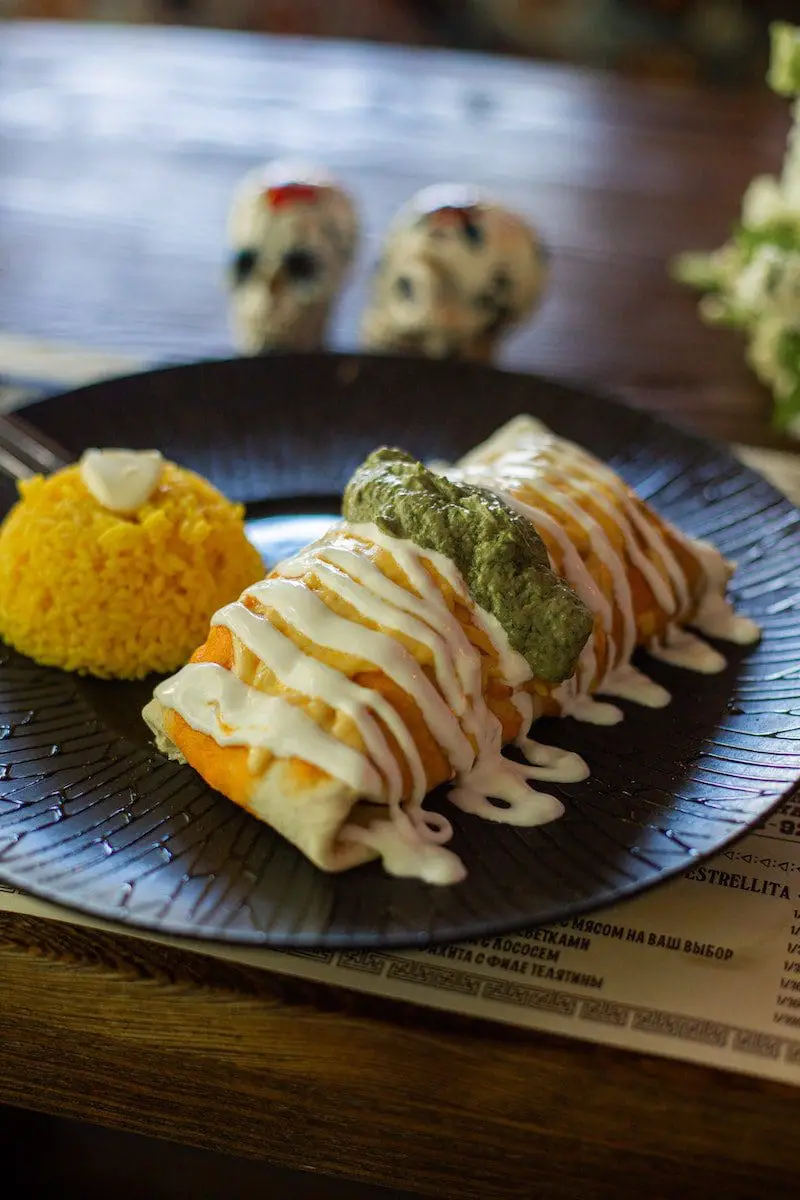Mexican dishes are quite famous all around the world. Tortillas can be used to make popular Mexican or Mex-Tex foods such as burritos, chimichangas, enchiladas, fajitas, and tacos.
The main distinction between a Burrito, Chimichanga, Enchilada, Fajita, and Taco is the content, tortilla type, and processing conditions. Wheat tortillas are used to make burritos and Chimichangas, while corn tortillas are used to make enchiladas.
Key Takeaways
- Enchiladas are soft corn tortillas filled with meat, cheese, or vegetables covered in sauce; chimichangas are deep-fried burritos.
- Enchiladas are a traditional Mexican dish; chimichangas originated in the southwestern United States.
- Enchiladas are baked and served with sauce; chimichangas are crispy and may be topped with various condiments.
Enchilada vs Chimichanga
An enchilada is a Mexican dish with a filling rolled inside a corn tortilla and covered in a savoury sauce. A chimichanga is a Tex-Mex dish that is common in other Southwestern U.S. cuisines as well. It is a deep-fried burrito that has a flour tortilla wrapped in fillings.

Enchiladas are made with a maize tortilla wrapped across a filling and topped with a spicy sauce. Enchiladas can be filled with several items, such as meat, beans, potatoes, cheese, veggies, or a mixture of these.
A chimichanga is just an over-fried burrito. The region and intentions of the cook influence the chimichanga’s filling. A variety of meats, as well as various ingredients such as cheese, beans, and Rice, are frequently encountered.
Chimichangas are frequently served with copious amounts of cheese, enchilada sauces, guacamole, and cream cheese as appetizers.
Comparison Table
| Parameters of Comparison | Enchilada | Chimichanga |
|---|---|---|
| Significance | Enchiladas are a type of enchilada that consists of a little maize tortilla folded around a filling. They’re presented with such a sauce bed and a dusting of butter on top. | Chimichangas resemble burritos that have been deep-fried. The ingredients change depending on where you are and what else the cook is looking for. |
| Sauce and Fillings | Both the sauces and also the fillings differ depending on where the person is and what they order. | Rice, beans, cheese, and several meat products are among the fillings. |
| Relation with Burritos | One of the biggest differences between enchiladas and burritos is that enchiladas are normally cooked with corn tortillas, whereas burritos are made using flour tortillas. | A chimichanga is a burrito that has been deep-fried. |
| Type of Dish | Enchilada is basically covering a filling in a tortilla as well as baking it in a sauce is a traditional Mexican meal. | Chimichanga is a moist burrito that has been deep-fried. As per some accounts, it started in Mexico, whereas others believe it happened by accident in Arizona, USA. |
| Served as | Enchiladas with mole that are covered with a mole sauce rather are served in some places. | Some individuals will pan-fry the burrito or use a panini press to avoid using just a frying pan, but that should actually be fried. |
What is Enchilada?
One of the famous Mexican dishes is enchiladas. Enchiladas are made with a huge tortilla folded around various fillings and salsas, similar to burritos.
Nevertheless, this simplistic enchilada description ignores the wide range of components that can be used in this Mexican cuisine, distinguishing these from a burrito.
Enchiladas have a strong tradition, but now they’ve developed into the dish people know today through time. The Aztecs are believed to have consumed enchiladas even before the Spanish came, although they wouldn’t look anything like the enchiladas that people find at restaurants nowadays.
In the United States versus Mexico, an enchilada is slightly different, yet both are wonderful.
Wheat tortillas packed along with a Relleno of commonly pre-cooked then chicken stock, steak, or pork, onions, jalapenos, and peppers, e.g., then put in a baked dish side by side, topped with grated cheese, sprinkled with red and green salsa, and roasted until lightly browned on the topping.
Enchiladas are made up of a large maize tortilla that is used to keep the various ingredients in place. These contents are frequently a blend of Rice, beans, meats, and vegetables, as well as a lot of salsa, just like burritos.
After being folded, the enchiladas would be topped with more salsa and cheese before being placed on a dish. One will need a knife and fork to consume an enchilada-style burrito because it’s a spicy dish!

What is Chimichanga?
The chimichanga’s origins are not known yet. According to a few stories, it began in Mexico, while others claim it began by chance in Arizona, United States.
Considering the use of the variety chimichanga in Mexico, one theory suggested that people in the U.s. brought the meal with them, mostly via Sonora and into Arizona.
The terms chimi and change are based on two main Mexican Spanish words: chamuscado, which implies burned or singed, and change, which would be linked to chinga.
A normal 183-gram (6.5-ounce) portion of meat and cheese chimichanga includes 443 kcal, 20 g protein, 39 g carbs, 23 g total fat, 11 g saturated fat, 51 mg cholesterol, and 957 mg of sodium. This is as per the Department of Agriculture data.
Chimichangas are widely regarded as among the tastiest Tex-Mex foods available. However, they might not have been the healthiest option. Because the chimichanga is deep-fried, it is high in saturated fat. The oils used for a frying pan may also be unhealthy for one’s heart.

Main Differences Between Enchilada and Chimichanga
- Enchiladas are a type of enchilada that consists of a little maize tortilla folded around a filling. They’re presented with such a sauce bed and a dusting of butter on top. On the other hand, Chimichangas resemble burritos that have been deep-fried. The ingredients change depending on where you are and what else the cook is looking for.
- The sauces and the fillings differ depending on where the person is and what they order in Enchilada, whereas Rice, beans, cheese, and several meat products are among the fillings of Chimichanga.
- One of the biggest differences between enchiladas and burritos is that enchiladas are normally cooked with corn tortillas, whereas burritos are made using flour tortillas. A chimichanga is a burrito that has been deep-fried.
- Enchilada is basically covering a filling in a tortilla as well as baking it in a sauce is a traditional Mexican meal. Whereas, Chimichanga is a moist burrito that has been deep-fried. As per some accounts, it started in Mexico, whereas others believe it happened by accident in Arizona, USA.
- Enchiladas with a mole that is covered with a mole sauce rather is served in some places. In the case of Chimichanga, some individuals will pan-fry the burrito or use a panini press to avoid using just a frying pan, but that should actually be fried.

- https://archives.datapages.com/data/gcags/data/047/047001/0485.htm
- https://books.google.co.in/books?hl=en&lr=&id=XRSFDwAAQBAJ&oi=fnd&pg=PT6&dq=Difference+Between+Enchilada+and+Chimichanga&ots=UZcnv1-LOU&sig=1onMgsGk-M5xp5Zg1GBkIhdRvmA&redir_esc=y#v=onepage&q=Difference%20Between%20Enchilada%20and%20Chimichanga&f=false

The detailed description of the components used in both enchiladas and chimichangas is fascinating. It’s amazing how the same core elements can result in such different dishes.
I couldn’t agree more. Learning about the variety of fillings and salsas used in these dishes was quite enlightening. It truly reflects the diversity of Mexican cuisine.
The detailed explanations of the traditional methods of preparing enchiladas and chimichangas were quite enlightening. It showcases the artistry involved in Mexican cuisine.
I completely agree. The traditional cooking methods and ingredients used in Mexican cuisine are truly remarkable and deserve to be celebrated. This article does a great job of highlighting that.
The comparison table is very helpful. It clearly outlines the differences in sauce, fillings, type of dish, and serving methods of enchiladas and chimichangas. It’s an informative read.
I found the comparison table extremely useful as well. It succinctly summarizes the key characteristics of each dish, making it easier to comprehend their differences.
The article’s detailed breakdown of the traditional components and preparation methods for enchiladas and chimichangas is highly informative. It’s a valuable resource for anyone interested in Mexican cuisine.
I wholeheartedly agree. The article provides a comprehensive understanding of these iconic Mexican dishes and their cultural significance.
I found the breakdown of the traditional elements and cultural significance to be incredibly insightful. This article is an excellent educational tool for those interested in Mexican gastronomy.
Fantastic explanation of the differences between these popular Mexican dishes and their origins. It’s interesting to see how their ingredients and preparation methods vary.
I completely agree! This article provided comprehensive details about enchiladas and chimichangas, making it easy to understand the distinction between the two.
The explanations of the cultural and historical context of enchiladas and chimichangas are incredibly enriching. It’s fascinating to learn about the diverse influences that have shaped these dishes.
I wholeheartedly agree. The cultural and historical insights provided in the article offer a comprehensive understanding of the culinary heritage behind enchiladas and chimichangas.
The cultural and historical explanations were certainly enlightening. It’s remarkable to see the diverse cultural influences that have contributed to the evolution of these iconic Mexican dishes.
The detailed comparison of the ingredients and cooking methods for enchiladas and chimichangas is highly informative. It provides a comprehensive understanding of these beloved Mexican dishes.
I completely agree. The article delivers a thorough analysis of the culinary intricacies involved in the preparation of enchiladas and chimichangas.
The information about the origins of chimichangas and the debate surrounding their creation is quite thought-provoking. It’s interesting to see the different perspectives on their history.
I found the debate about the origins of chimichangas intriguing as well. It adds an element of mystery and intrigue to the culinary history of this dish.
The thorough explanation of the differences in preparation and presentation methods between enchiladas and chimichangas is truly enlightening. It deepens the appreciation for these unique culinary creations.
The detailed explanations regarding the nuances of preparation and presentation methods are incredibly insightful. It’s amazing to see the intricate details that differentiate these dishes.
I couldn’t agree more. Understanding the nuances of preparation and presentation adds a layer of complexity to the culinary artistry of enchiladas and chimichangas.
The historical context provided for enchiladas and chimichangas adds depth to the understanding of these dishes. It’s interesting to see how they’ve evolved over time and across different regions.
Absolutely, the historical background highlighted in the article sheds light on the cultural significance of these dishes. It’s a great addition to the overall informative content.
The historical insights were definitely a highlight of the article for me as well. Understanding the cultural origins of these dishes enhances the appreciation of their culinary richness.